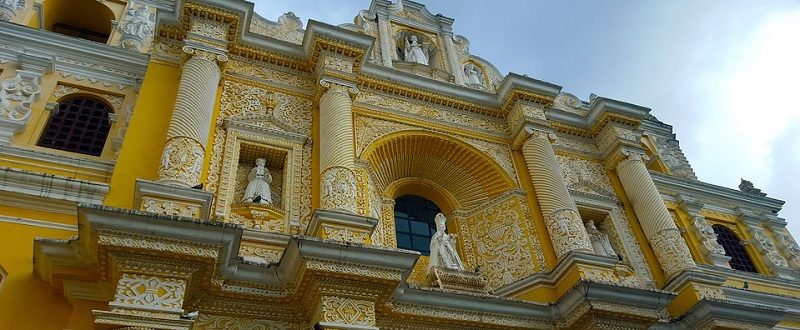
From the gorgeous colonial time-warp of Antigua to the volcano-framed waters of Lake Atitlan, and the Maya masterpiece of Tikal to the vibrantly colorful markets of Chichicastenango, Guatemala is one of Central America’s most inviting destinations. Countless memories of lush countryside and gracious people will stay with you long after your return.
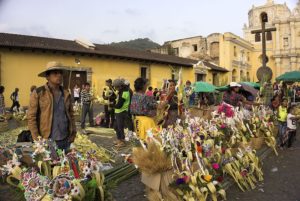 Intriguing and fascinating any time of year, the pre-Easter period of Lent is an exceptional time to be there: this is a country that has taken its tradition and religion seriously for centuries. Visitors are welcome to join the heartfelt celebrations when elaborate religious floats and ephemeral flower carpets highlight Semana Santa (Holy Week), culminating with the arrival of Easter Sunday.
Intriguing and fascinating any time of year, the pre-Easter period of Lent is an exceptional time to be there: this is a country that has taken its tradition and religion seriously for centuries. Visitors are welcome to join the heartfelt celebrations when elaborate religious floats and ephemeral flower carpets highlight Semana Santa (Holy Week), culminating with the arrival of Easter Sunday.
Antigua
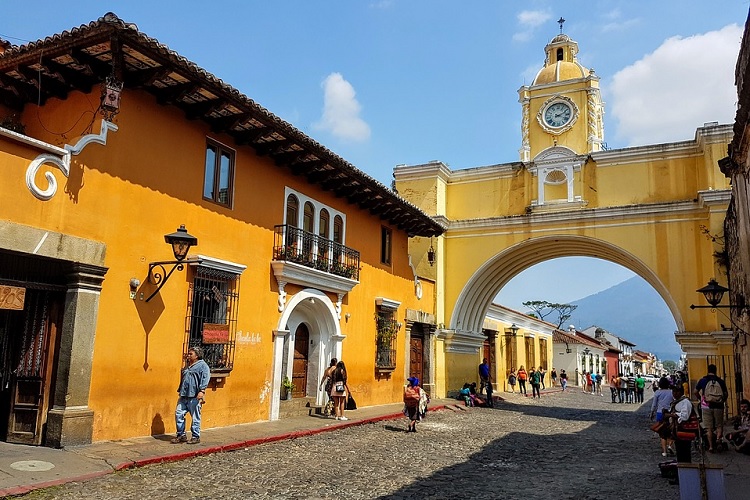
Gorgeously set in a green mountain- and volcano-rimmed valley, architectural monuments and poetic ruins make Antigua one of the Western Hemisphere’s best-preserved Spanish colonial cities. Founded in 1543, it was Spain’s prosperous capital of the middle Americas until the earthquake of 1773, when most residents left and moved the seat of government to Guatemala City, but the poorer families remained and Antigua never died.
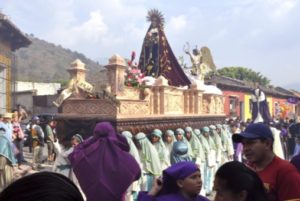 Today’s strict preservation ordinances protect what remains of its Spanish Renaissance and Baroque churches, monasteries, and homes, built between the 16th and 18th centuries. Some have been reconstructed, others remain evocative ruins, but they are all part of the lure for the wealthy weekend homeowners from nearby Guatemala City and the artistically inclined expats who flock here. The town center revolves around Plaza Mayor and Convento de las Capuchinas, so solidly built in 1736 that the earthquake damage was minor. It now serves as a museum dedicated to the history of the nuns who once lived there.
Today’s strict preservation ordinances protect what remains of its Spanish Renaissance and Baroque churches, monasteries, and homes, built between the 16th and 18th centuries. Some have been reconstructed, others remain evocative ruins, but they are all part of the lure for the wealthy weekend homeowners from nearby Guatemala City and the artistically inclined expats who flock here. The town center revolves around Plaza Mayor and Convento de las Capuchinas, so solidly built in 1736 that the earthquake damage was minor. It now serves as a museum dedicated to the history of the nuns who once lived there.
Distinguished by stucco pilasters, the brilliantly restored Baroque church Iglesia y Convento de Nuestra Señora de la Merced (known simply as La Merced) serves as the starting point for the city’s elaborate processions during Semana Santa (Holy Week), one of the most lavishly celebrated in Central America. The city can feel like one huge passion play during the Lenten season, as processions pass over intricate carpets of flowers and colored sawdust called alfombras, a tradition that originated in the 16th century.
Lake Atitlán
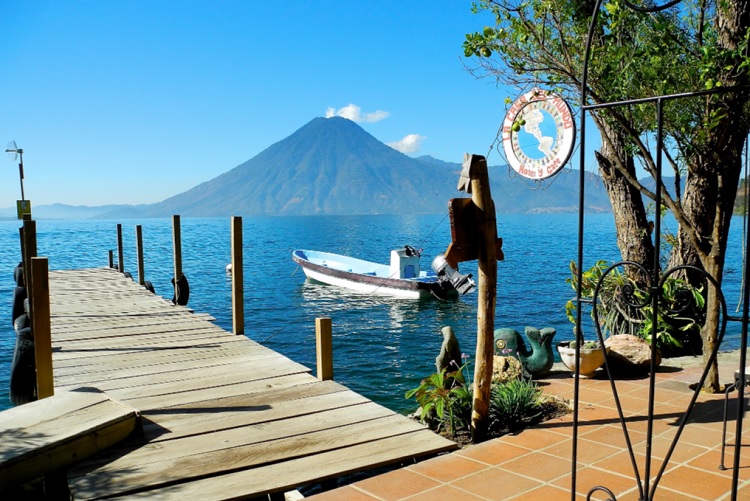
The Altiplano, Guatemala’s western highlands, is the country’s most stunning region, and blue-green Lake Atitlán—mirroring three Fuji-like volcanoes—its most perfect snapshot. Those who have seen it would agree with writer Aldous Huxley, who called it “the most beautiful lake in the world.” In certain seasons, the lake, under siege from human pollution, has experienced algae blooms the last few years, but international teams of scientists are working to alleviate the problem and to the average tourist there is no risk involved nor any visual conditions noticeable.
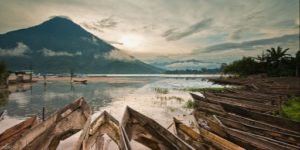 In the highlands surrounding the lake (a collapsed volcano cone that covers 50 square miles some hundred miles from the capital Guatemala City), descendants of the ancient Maya still live off the ash-rich land, their simple maize farming methods unchanged over time. A dozen lakeside villages and numerous mountain towns, where life and customs have changed little over the centuries, promise interesting day trips, particularly on market day, which varies from village to village.
In the highlands surrounding the lake (a collapsed volcano cone that covers 50 square miles some hundred miles from the capital Guatemala City), descendants of the ancient Maya still live off the ash-rich land, their simple maize farming methods unchanged over time. A dozen lakeside villages and numerous mountain towns, where life and customs have changed little over the centuries, promise interesting day trips, particularly on market day, which varies from village to village.
Tikal

In a vast empire that once encompassed Mexico, Belize, Honduras, El Salvador, and Guatemala, Tikal was the most resplendent of all Maya cities. A mighty religious, political, and military center, Tikal represented the apogee of Classic Maya civilization. Its pyramids and acropoli were the highest structures in the western hemisphere, and an estimated 100,000 people lived among them in a 10-square-mile area. It was abandoned by A.D. 1000, when its civilization collapsed. Only a small portion of Tikal has been excavated; nevertheless, more than 3,000 temples, ceremonial platforms, ball courts, and plazas now make up Guatemala’s most famous and impressive Maya ruin – a ghost metropolis – which is less crowded than the better-known sites of the Maya Heartland in Mexico’s Yucatán.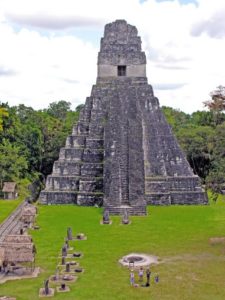
Tikal’s centerpiece is the Plaza Mayor (Great Plaza), flanked by tall, well restored temples. Soaring to 186 feet and 212 feet respectively, Temple V and Temple IV are the highest on the grounds, each an ideal perch from which to watch the sun set. Special passes are granted to visit the Great Plaza after hours on nights with a full moon, when Tikal is at its most magical. The ruins lie within the Tikal National Park, 222 square miles of dense jungle that, with over 400 species, ranks as a world-class birding destination.
Market at Chichicastenango
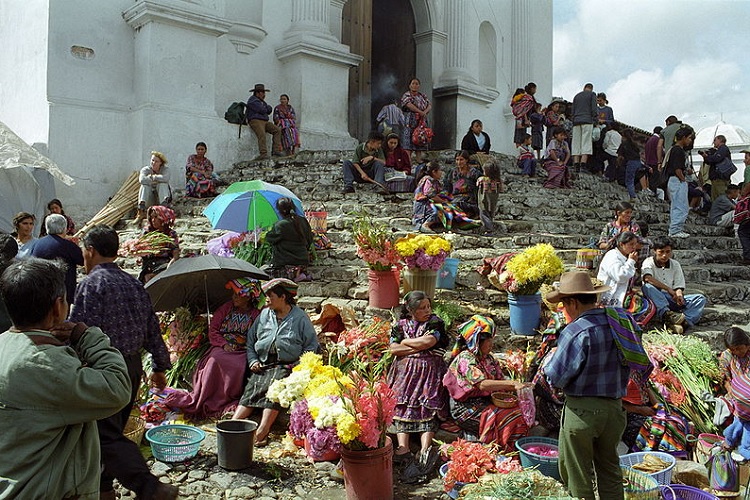
Guatemala’s largest market takes place in Chichicastenango, one of the country’s most colorful and accessible highland towns and an important trading center since pre-Columbian times. “Chichi” is famous for its indigenous arts and crafts, hand-woven textiles and blankets, and wooden masks. It draws tourists by the busload every Thursday and Sunday, who wander the market’s myriad stalls and head to the maze of comedores (open-air food stalls) to sample fried chicken and blue corn tortillas.
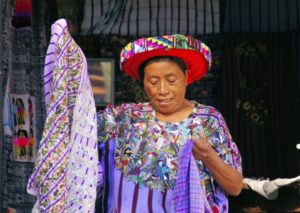 Chichi’s market is a popular day trip from Lago Atitlán and Antigua (above), but stay overnight to get the full experience of the market. Watch as Maya families from the highlands set out their wares and exchange news the night before, then settle in to sleep under the stars. Rise at dawn to watch the market swing into action, making sure to visit the inner nucleus around the fountain to find the most traditional goods. If you’ve come for Sunday’s market, visit the whitewashed 16th-century Church of Santo Tomás, where the cofradías, or traditional Catholic brotherhoods, often stage processions or ceremonies.
Chichi’s market is a popular day trip from Lago Atitlán and Antigua (above), but stay overnight to get the full experience of the market. Watch as Maya families from the highlands set out their wares and exchange news the night before, then settle in to sleep under the stars. Rise at dawn to watch the market swing into action, making sure to visit the inner nucleus around the fountain to find the most traditional goods. If you’ve come for Sunday’s market, visit the whitewashed 16th-century Church of Santo Tomás, where the cofradías, or traditional Catholic brotherhoods, often stage processions or ceremonies.
And don’t forget to check out the book!
 About the Book:
About the Book:
The world’s bestselling travel book is back in a more informative, more experiential, more budget-friendly full-color edition. A #1 New York Times bestseller, 1,000 Places reinvented the idea of travel book as both wish list and practical guide. As Newsweek wrote, it “tells you what’s beautiful, what’s fun, and what’s just unforgettable—everywhere on earth.” And now the best is better. There are 600 full-color photographs. Over 200 entirely new entries, including visits to 28 countries like Lebanon, Croatia, Estonia, and Nicaragua, that were not in the original edition. There is an emphasis on experiences: an entry covers not just Positano or Ravello, but the full 30-mile stretch along the Amalfi Coast.
Every entry from the original edition has been readdressed, rewritten, and made fuller, with more suggestions for places to stay, restaurants to visit, and festivals to check out. And throughout, the book is more budget-conscious, with starred restaurants and historic hotels such as the Ritz, but also moderately priced gems that don’t compromise on atmosphere or charm.
The world is calling. Time to answer.
Buy the Book
Amazon | B&N | Indiebound | Workman

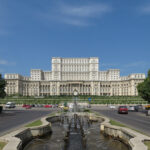
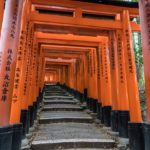
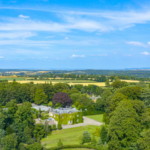
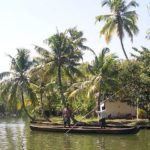
No Comments